If you find store-bought vegetable stock a bit bland or bone broth a bit gamey, I have an alternative you may want to try — making your own. With a little rough chopping and a couple of hours of hands-off simmering, you can convert a pile of fresh veggies into your own hearty and nutritious vegetarian broth. You can then transform this broth into any number of soups and stews — even bone broth.
When I created my Magic Mineral Broth some 17 years ago, I broke many so-called broth rules: Avoid using sweet potatoes because they make broth cloudy, for example, and never add greens because they make it bitter.
I tried it all anyway. During the experimentation and creation process, I felt like I had virtual grandmothers from around the world chiming in with ideas. There was the Japanese grandmother insisting on kombu — that umami-rich sea vegetable at the heart of dashi, a popular soup base in Japan. There was the Italian grandmother who swore by garlic, an essential component of any truly great broth.
In the end, I came up with a foundational recipe that I think is the epitome of culinary alchemy.
What sets a nourishing broth like this apart from the rest is that it stands on its own. You can savor it as is, or you can make it the base of your favorite soup. As a soup lover, that’s what I call magical.
Soup Recipes
Magic Mineral Broth
This broth is a veritable veggie-palooza that you can use as a base for many soups to be eaten from a bowl or sipped as a tea. It’s also a nutrient-dense, -cleansing elixir that’s delicious on its own.
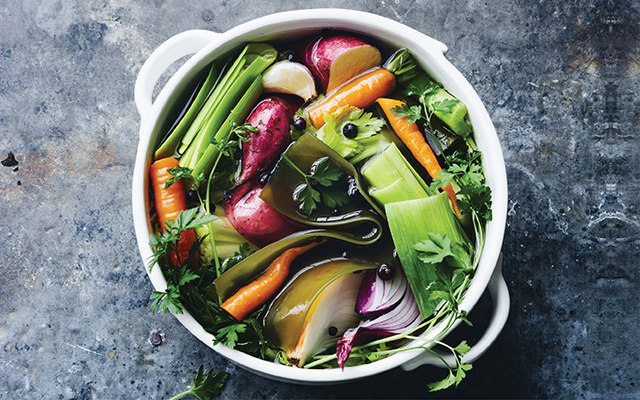 Photography by Eva Kolenko
Photography by Eva KolenkoMakes about 6 quarts
Prep time: 10 minutes
Cook time: two to three hours
Ingredients
- 6 unpeeled carrots, cut into thirds
- 2 unpeeled yellow onions, quartered
- 1 leek, white and green parts, cut into thirds
- 1 bunch celery, including the heart, cut into thirds
- 4 unpeeled red potatoes, quartered
- 2 unpeeled Japanese or regular (white) sweet potatoes, quartered
- 1 unpeeled garnet sweet potato, quartered
- 5 unpeeled cloves garlic, halved
- 1⁄2 bunch flat-leaf parsley
- 1 8-inch strip kombu
- 12 black peppercorns
- 4 whole allspice or juniper berries
- 2 bay leaves
- 8 quarts cold, filtered water, plus more if needed
- 1 tsp. sea salt, plus more if needed
Directions
- Rinse the vegetables well, including the kombu.
- In a 12-quart or larger stockpot, combine the vegetables and spices. Add the water, cover, and bring to a boil over high heat. Decrease the heat to low and simmer, partially covered, for at least two hours, or until you can taste the full richness of the vegetables. As the broth simmers, some of the water will evaporate; add more if the vegetables begin to surface.
- Strain the broth through a large, coarse-mesh sieve into a heat-resistant container, and discard the solids. Stir in the salt, adding more to taste if desired. Let cool to room temperature before refrigerating or freezing. Store in the refrigerator for up to five days or in the freezer for up to six months.
Tip: One of the more common sea vegetables, kombu is loaded with calcium, iron, and iodine. It also gives the broth the savory, rich flavor that’s known as umami.
Clean-Out-the-Fridge Soup
Veggies that are no longer in their prime are still great candidates for a hearty vegetable soup. This recipe provides a good guide — but, really, your options for ingredients are limitless.
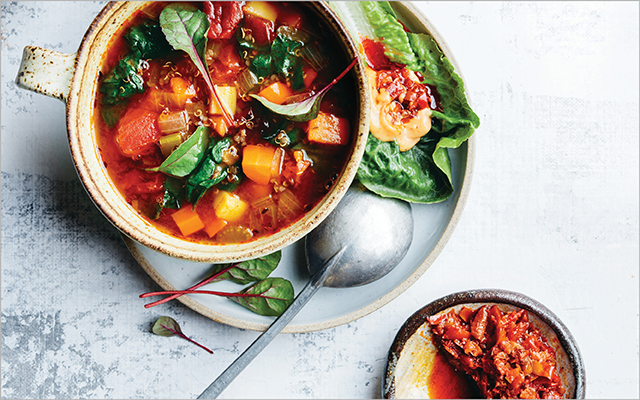 Photography by Eva Kolenko
Photography by Eva KolenkoMakes about six servings
Prep time: 20 minutes
Cook time: 40 minutes
Ingredients
- 3 tbs. extra-virgin olive oil
- 1 yellow onion, diced
- Sea salt to taste
- 2 carrots, peeled and diced
- 2 stalks celery, diced
- 2 parsnips, peeled and diced
- 1 sweet potato, peeled and cut into 1⁄4-inch cubes
- 2 cloves garlic, minced
- 1/2 tsp. dried thyme
- 1/2 tsp. dried oregano
- 1/8 tsp. red-pepper flakes
- 6 cups Magic Mineral Broth
- 1 tbs. tomato paste
- 1 14.5-oz. can diced tomatoes
- 1 bay leaf
- 1 cup cooked quinoa
- 1 small bunch kale, Swiss chard, or spinach, chopped into bite-sized pieces
Directions
- Heat the olive oil in a soup pot over medium heat. Add the onion and a pinch of salt, and sauté until translucent, about four minutes. Add the carrots, celery, parsnips, sweet potato, and 1⁄4 tsp. salt, and sauté until the vegetables are tender and turning deep golden brown, about 12 minutes. Add the garlic and sauté for about 30 seconds, and then stir in the thyme, oregano, red-pepper flakes, and 1⁄2 tsp. salt.
- Pour in 1⁄2 cup of the broth to deglaze the pot, stirring to loosen any bits stuck to the bottom, and cook until the liquid is reduced by half.
- Stir in the tomato paste, tomatoes, bay leaf, and the remaining broth. Increase the heat to high and bring to a boil. Decrease the heat to low, cover, and simmer until the vegetables are tender, about 15 minutes.
- Stir in the quinoa and kale, and cook for three minutes or until the kale is just tender. Taste; you may want to add another generous pinch of salt. Store in an airtight container in the refrigerator for up to five days or in the freezer for up to three months.
Moroccan Carrot Soup With Chermoula
Saffron can be costly, but just a pinch will give you a huge bang of flavor for your buck. Here it lends a luscious, exotic taste to the naturally sweet carrots.
 Photography by Eva Kolenko
Photography by Eva KolenkoMakes six servings
Prep time: 15 minutes
Cook time: 25 minutes
Soup Ingredients
- 2 tbs. extra-virgin olive oil
- 1 yellow onion, chopped
- 1/2 tsp. sea salt, plus more to taste
- 3 lbs. carrots, cut into 1-inch chunks
- 1 tsp. ground cumin
- 1/2 tsp. ground coriander
- 1/2 tsp. ground cinnamon
- Pinch red-pepper flakes
- 1/2 tsp. saffron threads
- 6 cups Magic Mineral Broth, plus more if needed
- 2 1/2 tsp. Meyer lemon zest (regular lemon zest is fine)
- 1 tbs. freshly squeezed Meyer lemon juice, plus more if needed (can substitute 2 tsp. lemon juice plus 2 tsp. freshly squeezed tangerine or orange juice)
- 1/4 tsp. dark maple syrup
Soup Directions
- Heat the olive oil in a soup pot over medium heat. Add the onion and a pinch of salt and sauté until golden, about four minutes. Stir in the carrots, cumin, coriander, cinnamon, red-pepper flakes, saffron, and 1⁄4 tsp. salt.
- Pour in 1⁄2 cup of the broth and cook until the liquid is reduced by half. Add the remaining broth and another 1⁄4 tsp. salt and cook until the carrots are tender, about 20 minutes.
- Put the lemon zest in a blender. Begin adding the soup in batches, each time adding some of the soup’s broth first and then some of the vegetables. Purée until smooth, adding more broth to reach the desired thickness.
- Return the soup to the pot over low heat, stir in the lemon juice, maple syrup, and a pinch of salt, and gently reheat. Taste; you may want to add another squeeze of lemon, a pinch of salt, or a drizzle of maple syrup. Serve with chermoula as garnish. Store in an airtight container in the refrigerator for up to five days or in the freezer for up to three months.
Tip: The carrots in this warming soup deliver a big shot of beta-carotene, a powerful antioxidant.
Chermoula
Makes 1 1/4 cup
Prep time: five minutes
Ingredients
- 1 cup packed fresh flat-leaf parsley
- 1/2 cup packed fresh cilantro or basil leaves
- 6 fresh mint leaves
- 1/2 tsp. ground cumin
- 1/2 tsp. paprika
- 1 clove garlic, chopped
- 1/4 cup extra-virgin olive oil
- 3 tbs. freshly squeezed lemon juice
- 1/4 tsp. sea salt
Chermoula Directions
- Combine all ingredients in blender or food processor until well mixed.
Kitchari
Kitchari means “mixture” in Hindi, and it’s a thousand-year-old staple in India. The traditional recipe is simple, made with basmati rice, mung beans, and ghee. This interpretation kicks things up a bit with onion, ginger, cauliflower, coriander, turmeric, and cumin.
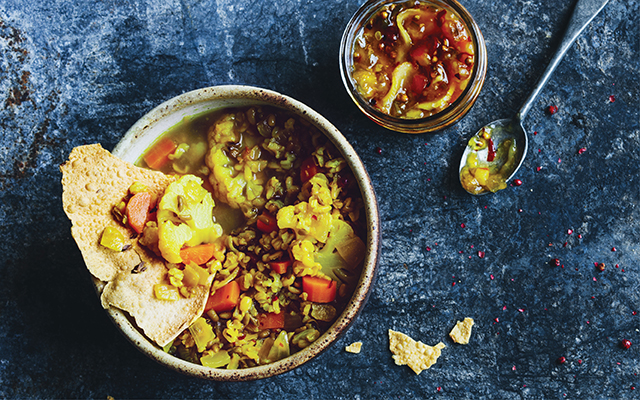 Photography by Eva Kolenko
Photography by Eva KolenkoMakes six servings
Prep time: 15 minutes plus eight hours to soak the beans and rice
Cook time: About one hour
Ingredients
- 2 tbs. ghee, extra-virgin olive oil, or coconut oil
- 1 onion, diced
- 2 tbs. minced fresh gingerroot
- 2 tbs. minced fresh turmeric
- 1/2 tsp. ground dried turmeric
- 1 tsp. ground cumin
- 1/2 tsp. ground coriander
- 1 1/4 tsp. sea salt, plus more if needed
- 1/2 cup split mung beans, rinsed and soaked*
- 1/2 cup brown basmati rice, rinsed and soaked*
- 5 cups Magic Mineral Broth, plus more if needed
- 1 head cauliflower, chopped into florets
- 2 carrots, peeled and diced
- 1 tsp. freshly squeezed lemon juice
- 2 tbs. minced fresh cilantro, for garnish
Directions
- Heat the ghee in a heavy-bottomed pot over medium heat. Add the onion and sauté for about four minutes, or just until golden. Stir in the gingerroot, fresh and dried turmeric, cumin, coriander, and salt, and sauté for about one minute. Add the soaked beans and rice, and stir to coat.
- Add 5 cups of the broth and bring to a boil. Decrease the heat to low and simmer, covered, for about 20 minutes, or until the rice begins to soften.
- Stir in the cauliflower and carrots, and continue to cook until tender and soft, another 20 minutes. Add more broth if soup becomes too thick.
- Stir in the lemon juice. Taste; the kitchari may need another spritz of lemon juice or another pinch of salt. Serve garnished with the cilantro. Store in an airtight container in the refrigerator for up to five days or in the freezer for up to three months.
* To soak the beans and rice, put each in a large bowl and add water to cover by 3 inches. Cover with a towel and soak for eight hours or overnight. Drain well just before cooking.
Tip: Kitchari tastes even better the next day! Add some broth or water to thin it out before reheating over medium-low heat.
Mediterranean Fish Soup With Many-Herb Drizzle
Here’s a great way to up your fish intake and get a blast of protein and energizing vitamin B12. And it’s an easy way to prepare fish — much easier than you might think. All you do is poach it for four minutes, and it’s ready to go. Any white fish will work; check Monterey Bay Aquarium Seafood Watch at www.seafoodwatch.org for safe and sustainable choices, such as black cod or bass.
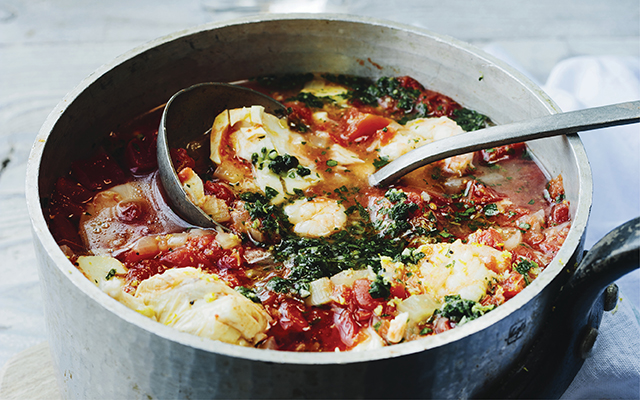 Photography by Eva Kolenko
Photography by Eva KolenkoMakes about four servings
Prep time: 25 minutes
Cook time: 20 minutes
- 2 tsp. extra-virgin olive oil
- 1 onion, diced
- 1 fennel bulb, diced
- Sea salt
- 2 cloves garlic, minced
- 1/8 tsp. red-pepper flakes
- 1 14.5-oz. can diced tomatoes
- 3 cups Magic Mineral Broth
- 1 lb. white-fleshed fish, deboned and cut into 2-inch pieces
- 1 lb. large shrimp, peeled and deveined
- 1 tsp. lemon zest
- 1/4 tsp. freshly ground black pepper
- 1 tbsp. chopped fresh parsley
Directions
- Heat the olive oil in a soup pot over medium-high heat. Add the onion, fennel, and 1⁄4 tsp. salt, and sauté until the vegetables begin to soften, three to five minutes. Stir in the garlic and red-pepper flakes, and sauté for 30 seconds more. Add the tomatoes with their juice and 1⁄4 tsp. salt to deglaze the pot, stirring to loosen any bits stuck to the bottom.
- Add the broth and bring to a boil. Decrease the heat to low, cover, and simmer until the vegetables are just tender, about eight minutes.
- Gently stir in the fish and shrimp, and simmer until the seafood is tender and cooked through (it should be just opaque), about four minutes.
- Stir in the lemon zest, black pepper, and parsley. Taste; you may want to add a pinch or two of salt. Serve garnished with the herb drizzle, or store in an airtight container in the refrigerator for up to three days or in the freezer for up to three months.
Many-Herb Drizzle
- 1 cup tightly packed chopped fresh flat-leaf parsley
- 1/2 cup tightly packed fresh mint leaves
- 2 tbs. chopped fresh chives
- 2 tbs. freshly squeezed lemon juice
- 1/4 tsp. sea salt
- 1/4 cup extra-virgin olive oil
Directions
- Combine all ingredients in blender or food processor until well mixed.
Reprinted with permission from Clean Soups, copyright by Rebecca Katz with Mat Edelson, 2016. Published by Ten Speed Press, an imprint of Penguin Random House LLC. Photographs © 2016 Eva Kolenko.
Why No Numbers? Readers sometimes ask us why we don’t publish nutrition information with our recipes. We believe that (barring specific medical advice to the contrary) if you’re eating primarily whole, healthy foods — an array of sustainably raised vegetables, fruits, nuts, seeds, legumes, meats, fish, eggs, whole-kernel grains, and healthy fats and oils — you probably don’t need to stress about the numbers. We prefer to focus on food quality and trust our bodies to tell us what we need. — The Editors
This article originally appeared as “Soup’s On!” in the November 2021 issue of Experience Life.
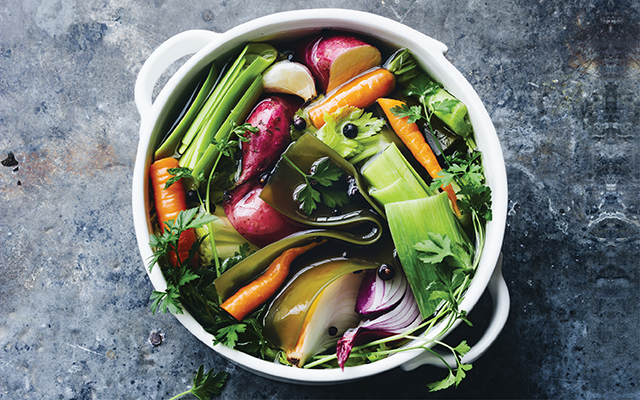
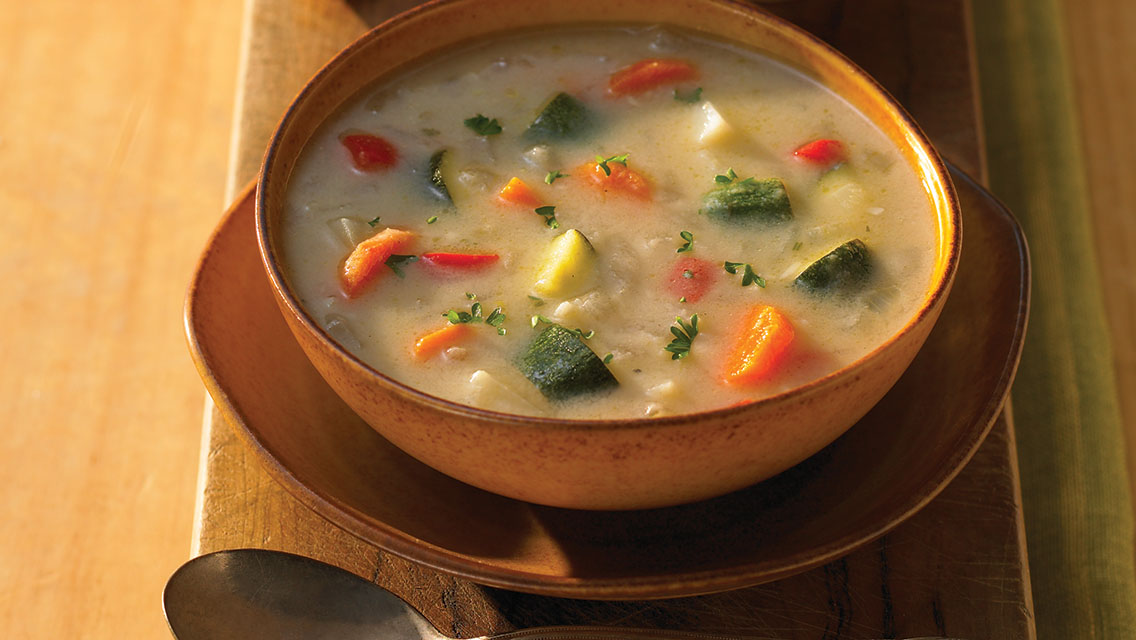
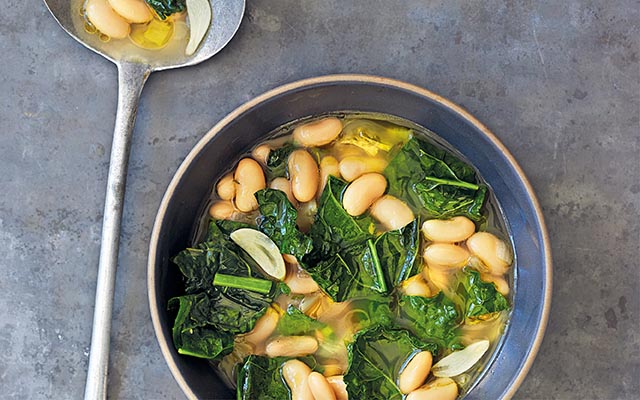
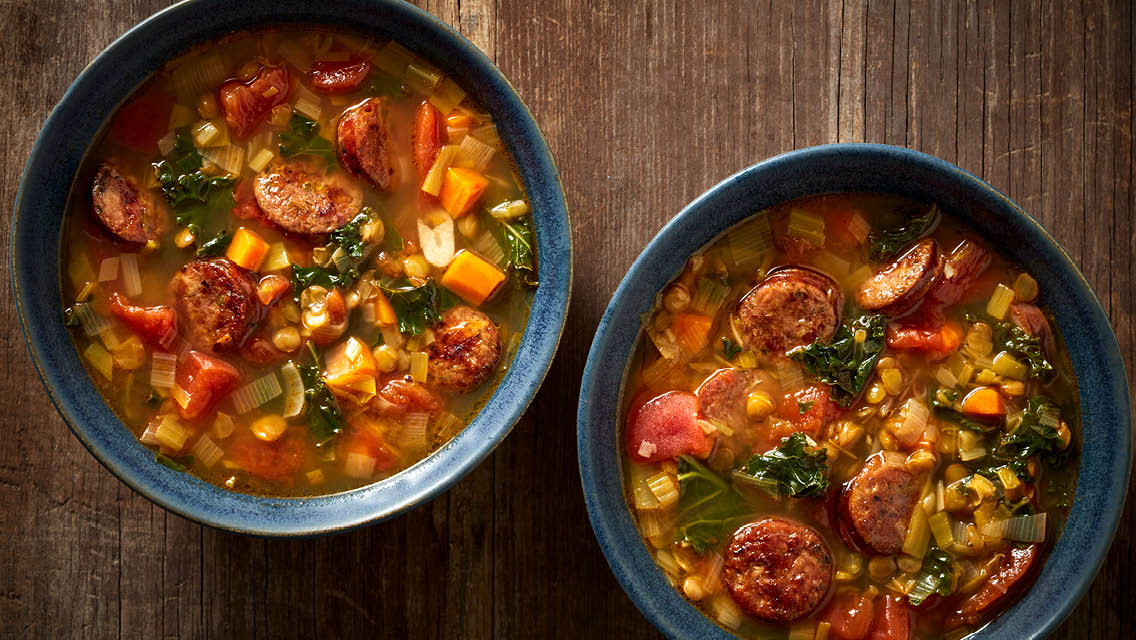
This Post Has One Comment
I was curious about canning the broth. Would you waterbath or pressure can? I don’t have a lot of freezer room.
Thanks